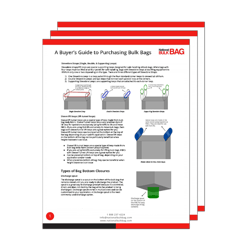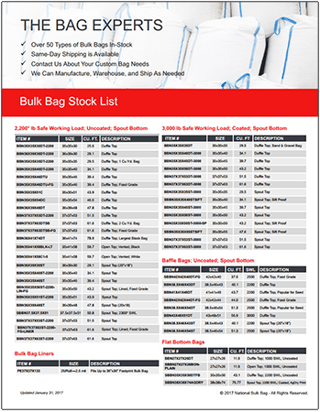There are many different ways to fill FIBC big bags in your facility. One of the most common and practical ways is using specialized filling machines designed to make filling bulk bags clean, efficient, and safe.
There are many different FIBC big bag fillers that come in a variety of sizes and designs. What’s best for your company and employees largely depends on your product, application, and facility. Finding the right filling equipment is all about your own unique situation and needs within your facility.
Common Filling Equipment for FIBC Big Bags
Stand-alone fillers
Stand-alone fillers are one of the most common types of automated big bag filler. They are simple in design, easy to operate, and can work in a wide variety of facilities. The filler discharges material from the top of the machine into the bag below. Generally, they are paired with spout top bulk bags as the spout top can be tightly fitted to the discharge hose on the machine. This prevents any material from spilling during the filling process. Simply attach the bag at the top, auto-fill, stop and detach.
Stand-alone fillers can be easily added to a conveyer line and/or fill FIBCs on pallets for use with forklifts. Stand-alone fillers are a great solution if you already have a system for moving materials and could easily connect the machine to your production line. They are versatile in nature, very easy to use, and significantly reduce bag filling times within facilities making them very popular options.
Conveyor fillers
Conveyor-type big bag fillers (tubular cable conveyors, flexible screw conveyors) differentiate themselves from stand-alone fillers in their ability to transport materials from any place in your facility, to the filling area, and into the bag. With stand-alone fillers, materials must be loaded into the filler from above the machine. Conveyor fillers offer a type of 2-in-1 solution - both transporting the materials to the loading site, and into the bag itself.
There are a few different types of conveyor fillers ranging from a simple flexible screw conveyor to more advanced modular tubular cable conveyors. The best fit largely depends on how much material you are moving and your facilities’ capacity/size. Modular tubular systems offer complex, facility specific designs to quickly move materials throughout your facility and into FIBCs. Flexible screw conveyors are simpler in nature and often move materials from a dumping site at the ground level into the filling spout above the bag and into the bag itself. However, all conveyor-type filling systems are unique in their ability to move materials horizontally and vertically before the filling process.
Conveyor fillers offer a more comprehensive big bag loading system versus stand-alone fillers. If you want to quickly move materials from one place in your facility into one or many bulk bags, conveyor systems are often a fast and efficient way to do so.
Pneumatic systems
The most complex and heavy duty of all the automated filling systems is the pneumatic systems. These systems are designed for the transport of large amounts of multiple different material types around your facility and ultimately into big bags (or other bulk material containment systems). They can be used in single-point systems to simply move materials up and into bags but are more practical in large-scale operations. They use heavy vacuum systems and blower air pressure systems to move large amounts of a variety of materials quickly throughout a facility.
They are completely enclosed systems that ensure materials are properly handled and contaminates are kept out. This can be particularly useful in facilities operating with food products. They are highly customizable and reliable as well as easy to maintain.
Finding a Good fit
Finding the right solution for your facility is all about fit. Does the machine fit (literally) into my facility? Does it meet my needs in terms of transporting/filling materials? Does it fit into my budget?
These are all important questions to ask. Often times, a variety of filling equipment could work for your product, application, and facility – that’s when costs come into play. Other times, you need a particular solution in order to properly address needs.
For example: facility A needs to move multiple materials throughout their entire facility before loading into big bags may find a conveyor or pneumatic system to be the best fit. It not only fills the bags for them, but also gives them the automated material transport they currently don’t have.
Facility B already has an installed conveyor system. A stand-alone filling system would be ideal as they already have a solution for moving materials throughout their facility. They have a more simple need for a plug-and-play big bag filling system that fits into their current process.
Thanks for reading!
 Thanks for reading our blog post "Common Filling Equipment for FIBC Bulk Bags"!
Thanks for reading our blog post "Common Filling Equipment for FIBC Bulk Bags"!
It's our mission to make your buying experience easy, informative, and enjoyable. We also want to share our knowledge with you so you can make the best purchasing decision for the company you represent. Our Buyer's Guide to Purchasing Bulk Bags includes critical information ranging from types of bags to important safety information about handling and transportation.
Click the button below to download our comprehensive buyer's guide.






